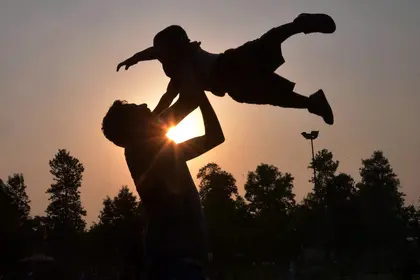When my parents and my one-year-old sister came from Germany to America in 1951, they were forced to stay on New York’s Ellis Island for six months until they were allowed to go to Manhattan Island. This delay happened because of the affiliation of my father Evhen Lozynskyj to the Organization of Ukrainian Nationalists (OUN). Since my father had not openly declared his affiliation to the OUN – because the OUN was an underground organization – there was a suspicion in our family that someone had passed on this information.
Or maybe not, because my father’s activities as a nationalist were quite evident. He had three arrests for OUN activities under Poland and one with a long prison and camp term under the Germans. My father never learned the full truth about the detention of his family. Only later did it become clear that the reason for the detention was his membership in the OUN.
JOIN US ON TELEGRAM
Follow our coverage of the war on the @Kyivpost_official.
This information appeared much later, almost 25 years on. Some documents were declassified. It turned out that the US Displaced Persons Commission used a primitive – compiled by various sources including Soviet agents – “List of Organizations Considered Inimical to the United States.” The Displaced Persons Act of 1950 was meant to correct the deficiencies of the 1948 Act.
While the revised bill did not exclude former Nazis and Nazi collaborators by name, it did ban “any person who advocates or assists in the persecution of any person because of race, religion or national origin.” To help US consuls and their investigators enforce the ban, the Commission on Displaced Persons compiled an “Inimical List” for each country of more than 275 organizations. Any applicant who belonged to any of these organizations would not be eligible for a visa.
There were seven Ukrainian organizations or institutions on this list: Office for Ukrainian Affairs in Germany, Ukrainian Youth Committee (KUM), Ukrainian Military Association (UWO), Ukrainian National Association (OUN), Ukrainian Aid Committee, the 14th Galician Waffen SS Division (Divisia Halychyna), agents and members of the Ukrainian Intelligence Service. The names are set forth as primitively as the list was compiled.
A review of several documents of specific persons to whom the Commission refused a visa to the United States is telling: for membership in the Bandera party, the Ukrainian Insurgent Army (UPA), The Ukrainian Youth Association (SUM), OUN, “Halychyna” Division, and the Ukrainian Supreme Liberation Council – the nationalist would-be government.
A document from December 1, 1950, describes the OUN:
“The OUN was formed in 1929 by [Yevhen] Konovalets in order to win Ukrainian independence. In 1940, it split into two parts: one group of [Stepan] Bandera, and the other of those loyal to Melnyk. Both groups actively cooperated with the Germans in 1941-1942. In June 1942, Bandera tried to declare the independence of Ukraine in Lviv, but the Germans resisted this effort. Due to German opposition to their plans, both groups became underground terrorist organizations. Bandera’s group in particular became infamous for its abuses that took place in Galicia. For example, the burning of Polish villages was the work of Bandera’s group.”
In such a suspicious if not hostile atmosphere, fostered by Soviet influence and sources, it is difficult to explain at all how the Lozynskyj family managed to free themselves from Ellis Island and come to Manhattan Island, on Seventh Street, to their sponsor.
My father suspected that the fact that my father was liberated from the Auschwitz concentration camp by American forces had a plausible positive impact on the final decision. My father probably didn’t have documentation of his internment by the Nazis, but his left arm likely provided evidence, since there was the prisoner number forever inscribed, which the German guards wrote with a needle and ink on the prisoners’ arm. This number became the passport for the Lozynskyj family to America.
American politics at that time were generally naive, if not hopelessly ill-informed. There is much unclassified documentation that sheds light on how the US State Department at that time treated Ukrainians and the immoral principle of “Russian unity,” considering Ukrainian nationalists as separatists and even terrorists.
The great friendship between US President Franklin Roosevelt – with his hapless, or at least feckless foreign policy – and the murderous Soviet dictator Joseph Stalin had lasting effects. In addition, the American side was infiltrated by American communists, many of whom served the USSR as agents in America.
Such were the times, and it took much longer for the Americans to gain some sense as to what Russians were like and how they remain that way – as well as their mantra of lasting empire by oppression of other nations. There has been much progress in this regard, owing not least to the efforts of the Ukrainian political diaspora, as well as independent, democratic, tolerant, diverse forces. But above all, indomitable Ukraine, which has shown the world much during its 30-plus years of independent existence.
Unfortunately, people like my father and many of his generation did not live to see this, but their great merits in this direction are undeniable. I would be remiss if I failed to remember my father and his generation of Ukrainians on this Father’s Day.
The views expressed in this opinion article are the author’s and not necessarily those of Kyiv Post.
You can also highlight the text and press Ctrl + Enter



